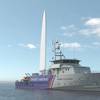Maritime Satellite Markets on Cusp of Bandwidth Revolution
NSR's Maritime Satellite Markets report projects the market is entering the next phase of development aided by higher bandwidth offerings, increased regulations and a more demanding addressable market. In total, NSR forecasts the maritime satcom market to generate almost $4 Billion in revenues, demand for 200 transponders of FSS capacity and 28 Gbps of HTS capacity, and over 1 Million In-service Units by 2022.
"With the launch of GEO-HTS maritime services just on the horizon and MEO-HTS not far behind, maritime markets are on the cusp of a bandwidth revolution -- yet, more data can also come in small bytes," explains Senior Analyst and report author, Brad Grady. "Narrowband MSS will account for a majority of maritime satellite terminals, enabling everything from engine monitoring, to safety and distress. However, broadband continues to be a major driver of revenues and In-service Units across all sectors of the maritime market." FSS C-band continues to grow -- but is vastly outpaced by FSS Ku-band and HTS solutions. GEO HTS from 2012 - 2022 will add almost as many In-service Units as FSS Ku-band.
By 2022, Merchant Maritime will account for the majority of the 1 Million In-service Units. However, passenger markets demand more bandwidth -- accounting for demand of almost 60 transponders of FSS capacity, and over 6 Gbps of HTS capacity. Government and military markets face near-term budget problems, but are expected to recover fully by 2022. The offshore market continues on a growth-path, adding more than 50,000 In-service Units over the next ten years. And, although the fishing market is the largest addressable market -- it still remains a limited opportunity for satellite players.
nsr.com












